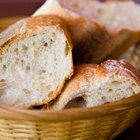
Pizza connoisseurs agree that the perfect crust is crisp and golden brown, and crunches when you bite down. The inside of the crust should be tender and the crust as a whole should be flavorful enough to complement the chosen toppings. When it comes to crust, pale and doughy just doesn't cut it. If your pizza dough refuses to brown despite ample time in a hot oven, the bakeware or the dough itself may be to blame.
Maillard Browning
The Maillard reaction is responsible for browning. When exposed to intense oven heat, sugar and protein molecules on the surface of the dough undergo a complex chemical reaction. This reaction is the catalyst that sets browning into motion.
The Overproofing Problem
The most likely reason for your pizza dough’s failure to turn brown is something called overproofing -- over-rising is another name for it. Sugar and yeast within the dough are responsible for its rising powers. When both are exhausted by overproofing, neither has the energy to complete the browning reaction inside the oven. So much sugar is consumed by the yeast in overproofed pizza dough that little to none is left to combine with the protein and create Maillard browning. Instead of having a crispy brown crust, overproofing ensures that your pizza will remain a doughy white.
Perfect Proofing
During proofing, yeast digests sugar in the dough, producing the carbon dioxide that makes the dough expand. Whether proofed in ball form or rolled out, pizza dough is fully risen when it doubles in size. If it is overproofed, it is dry, ripply and collapses when poked with a finger. Dough that is already collapsed, with an off odor that smells like beer, is unusable. When you poke perfectly proofed dough, you can see the indentation, but the dough does not collapse -- it's the perfect dough for pizza crust browning.
Moisture and Heat
Proofing aside, moisture and uneven heating are problems that may affect browning. The bakeware you choose must absorb the moisture that leaches from the dough or deliver enough heat to make moisture a nonissue. A ceramic baking stone or dark metal -- anodized aluminum or blue steel -- baking pan can do just that. The darker the metal, the quicker the heat is delivered, and the crispier and browner the pizza.
Browning the Top and the Bottom
The average oven temperature for pizza is between 450 and 550 F. If the temperature is right, but the pizza isn’t browning, check placement. If the bottom of the dough browns and the top doesn’t try moving the pizza up a rack. If the complete opposite happens, where the top of the pizza reaches a golden brown and the bottom remains milky white, transfer the pizza to a lower rack.
Related Articles
Can I Bake a Homemade Pizza on a Pan ...

How to Make Bread Chewy

What Are the Causes for an Uncooked ...

How to Bake Bread in the Oven

Does Heat Transfer Evenly Through ...

How to Cook Bread by Steaming It

How to Grill With a Pizza Stone and ...

How Long and at What Temperature Do You ...

Directions for Cooking Frozen ...

How to Bake Cookies That Are Not Burnt ...

How to Cook Cakes and Biscuits in a ...

Do You Have to Allow Pizza Dough to ...

Will Freezing Kill Mold on Bread?

Difference Between Baking on the Top & ...

How to Get Pizza Crust to Brown

Does Bread Expire?

How to Make Elastic Pizza Dough So You ...

How to Cook Two DiGiorno Pizzas at Once

Why Do Cheeses Brown When Placed Under ...

How Long to Bake a Pizza With Lots of ...
References
Writer Bio
Jonae Fredericks started writing in 2007. She also has a background as a licensed cosmetologist and certified skin-care specialist. Jonae Fredericks is a certified paraeducator, presently working in the public education system.
Photo Credits
Spike Mafford/Photodisc/Getty Images